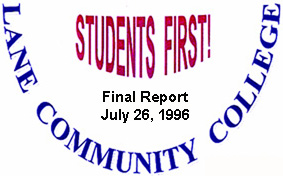| Lane Home Page | Search Lane |
| Website Accessibility |

STUDENTS FIRST! PROCESS REDESIGN Return to Change Proposal List SERVICE: Financial Transactions - Billing Statement Current Situation: If a student charges tuition and fees on ClassLine or charges books, supplies or other services and does not pay in full before the billing date, a billing statement (i.e., statement) is sent. An average of 8500 statements are mailed each month. The format of the statement divides the transactions by term, contains the student's class schedule, public service messages, and other information not directly related to the current activity. Often the class schedule information is not for the current term. There are also several optional messages that can be added to the statement including information about campus events (e.g. student elections). The OSRL survey indicated that two-thirds of respondents received monthly billing statements. In input session, students strongly voiced dissatisfaction with the statements. They reported a lack of standard billing, confusing mailing and payment due dates, unclear charges, and cluttered general layout. The OSRL survey included the following comments:
'It could be more specific for what the bills are for.' In input sessions, staff from a variety of departments expressed dissatisfaction and frustration with their inability to help students understand the statement's content. The Admissions Office receives hundreds of calls each month because their phone number is prominently displayed on the statement. Financial Aid staff receive many inquiries both in person and by phone but are unable to respond because the statement is too complicated to read and explain. In addition to dissatisfaction with the content and format of the statements, College Finance staff commented extensively on the administrative difficulties with producing, printing and mailing the statements. The process of establishing the criteria for statement content requires manual monthly updates of at least ten data tables. The chance of incorrect data updates is high, causing incorrect information on the statements or restarting the billing process. It is College Finance policy to retain a record of every statement sent. As a result, over seven million records are reviewed by the computer program each time statements are produced. In July 1996, the program had to be restarted twice and delayed at least one day. Lane contracts with a mailing service for preparing and mailing the statements. Because of delays in creating the statements and the mailing service's required processing time, it is generally a week or more after the closing date before a student receives the statement. Desired Situation: A clear, understandable, detailed, and self-explanatory billing statement. Students receive statements in a timely manner and payment dates are standard. A decrease in inquiries to staff and quicker processing turnaround. Proposed Solution: Redesign the monthly accounts receivable billing statement so that it contains detailed, uncluttered descriptions of charges and credits. Obtain the input of both students and staff concerning statement features. Simplify the computer process for creating the statements by reducing the number of records examined and the number of table and manual entries required each month. Use a self-mailer form that would not require outsourcing preparation. Direct mailing of statements would allow Lane to control delivery time and reduce the number of forms required per statement from three to one.
Coach (from Redesign Team): Kay Malmberg
Action Plan For Implementing Solution:
Return to Part Seven of the Redesign Change Proposals |
>> Return to Lane's Home Page >> Return to Process Redesign Project Main Page >> Return to top of page Lane Community College - Process Redesign Project 4000 East 30th Avenue, Eugene, OR 97405 Please direct comments about this site to webmaster@lanecc.edu Revised 12/2/96 (llb) © 1996-present Lane Community College |
